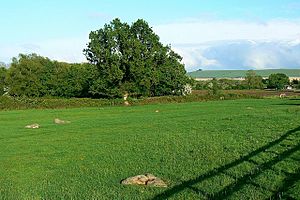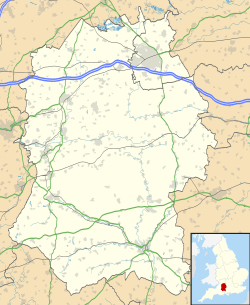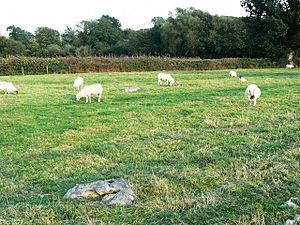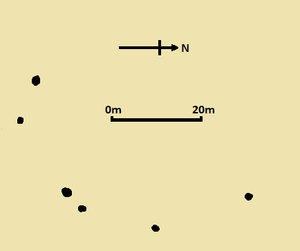Day House Lane Stone Circle facts for kids

The five stones of the Day House Lane Stone Circle
|
|
| Alternative name | Coate Stone Circle |
|---|---|
| Location | Near Coate |
| Coordinates | 51°32′24″N 1°44′20″W / 51.540°N 1.739°W |
| Type | Stone circle |
| History | |
| Periods | Neolithic / Bronze Age |
The Day House Lane Stone Circle, also called the Coate Stone Circle, is an ancient stone circle. You can find it near the small village of Coate, which is now part of Swindon in Wiltshire, England. Today, only five large, partly buried stones are left at the site.
This stone circle was made from huge stones called sarsens. Experts believe it was originally about 69 meters (226 feet) wide. It might have had more than thirty stones when it was first built! This circle was one of at least seven stone circles in the area south of Swindon.
The first time someone wrote about this site was in the 1860s. This was done by a local writer named Richard Jefferies. Later, in the 1890s, a researcher named A. D. Passmore studied the site. He found nine stones, most of them buried. He also saw a line of five stones nearby. He thought these might have been part of an ancient path leading to the circle. Sadly, these extra stones are no longer there today.
Building stone circles was a tradition across Britain, Ireland, and France. This happened during the Late Neolithic (New Stone Age) and Early Bronze Age. This period lasted from about 3300 to 900 BCE (Before Common Era). We don't know the exact reason why these monuments were built. Some archaeologists think the stones might have stood for special spirits or gods.
Contents
Where is the Day House Lane Stone Circle?
The stone circle is right next to Day House Farm. It sits on flat, clay ground at the bottom of a chalk hill. From this spot, people could probably see other ancient monuments on the Ridgeway path.
The circle is about a quarter of a mile from Coate village. It is also two miles southeast of the center of Swindon. The famous Avebury stone circle is about 9 miles (14 km) northeast of here. The Day House Lane Stone Circle is a Scheduled Ancient Monument. This means it is a protected historical site under a special law.
Why Were Stone Circles Built?
Around 3000 BCE, people in southern and eastern England started building different kinds of monuments. They stopped making the long burial mounds and large enclosures from earlier times. Instead, they began building circular monuments. These included earthen henges, wooden circles, and stone circles.
Stone circles are found in most parts of Britain where there was stone available. They are very common in southwest Britain and northeast Scotland. People built these circles for a very long time, from 3300 to 900 BCE. The main period of building was between 3000 and 1300 BCE.
These ancient stone circles often show little sign of people visiting them right after they were built. Because of this, some historians think the circles were not used for big public events. Instead, they might have been left as "silent and empty monuments."
One archaeologist, Mike Parker Pearson, believes that in ancient Britain, stone was linked to the dead. Wood, on the other hand, was linked to the living. Other archaeologists suggest that the stones might not have represented ancestors. They could have stood for other powerful beings, like gods.
Wiltshire, the county where Day House Lane Stone Circle is, has many stone circles. The most famous ones are Avebury and Stonehenge. Most of the other circles in Wiltshire are now ruined or completely gone. Many of these circles were built in low-lying areas.
South of Swindon, at least seven stone circles are known to have existed. They were often only a few miles apart. For example, the Day House Lane Stone Circle is 2 km northeast of the Fir Clump Stone Circle (which is now destroyed). The Day House Lane Stone Circle is one of the few northern Wiltshire circles that still survives today.
What Did the Day House Lane Stone Circle Look Like?
In the 1890s, A. D. Passmore guessed that the circle was about 69 meters (225 feet) across. He thought it might have been a bit uneven in shape. Based on the stones he found, Passmore believed the circle once had over thirty stones. The stones used were sarsens, a type of hard sandstone.
In the 1890s, Passmore found nine stones that were part of the circle. But by the early 2000s, only five were left. Passmore's study showed that some of the stones were up to 3 meters (10 feet) long.
It's possible that there were lines of stones, like paths, leading to the circle. In the 1890s, Passmore saw a line of five stones heading north from the circle. This might have been one of these ancient paths. However, these stones are also gone today. In 2009, during road work, two large sarsen boulders were found near Day House Farm.
In 1980, archaeologist Aubrey Burl said the circle was "almost completely overgrown." He repeated this in 2000. However, the official listing for the site still calls it a "comparatively well preserved example."
How Was the Circle Discovered and Studied?
The first known mention of the Day House Lane Stone Circle was around 1867. The writer Richard Jefferies described finding it. He knew the area well, and his wife had lived at Day House Farm. His notes about the circle were published after he died, in a book from 1896.
Jefferies wrote that he found "five Sarsden [sarsen] stones much sunk into the ground." He said they formed a half-circle. He also mentioned a sixth stone that had been removed to improve the road. He thought it looked like a "Druidical" circle, possibly made by the druids. Jefferies also saw three more sarsens in a nearby field, one much larger than the others.
A. D. Passmore's Study
The researcher A. D. Passmore wrote about his study of the stone circle in 1894. He thanked the farmer, W. Handy, for letting him explore the fields. Passmore noted that when he first found the stones in 1893, they were all lying down and mostly buried. They were "not at all conspicuous," meaning they were hard to see. None stuck out more than 18 inches from the ground.
Passmore used an iron bar to find the buried stones and measure them. He also dug between two stones and found burnt sarsen and white ash. This showed that sarsen stones had been burned and cracked at the site. He noticed that the western part of the circle was used for farmyards. He thought most of the stones there had been broken up or removed. He saw "big fragments" of sarsen and sarsen paving nearby. This suggested these stones were once part of the circle but were later reused.
Passmore also found three large sarsen boulders southwest of the farmhouse. One was lying on its side and was very long. He heard from an old man that other stones in this field had been broken up years ago. The old man thought there had once been a full circle of stones in that field. Passmore also found flint tools and pieces of pottery near these sarsens.
Passmore also looked at a row of five stones next to the road in front of the farm. He thought this might have been an ancient path leading to the north side of the Day House Lane Stone Circle. He didn't think farmers had just moved these stones to the side of the road. He reasoned that if they wanted to remove them, they would have broken them into smaller pieces instead of moving them whole.
Protecting This Ancient Site
In the late 2000s, there were plans to build 1,800 homes and a university near Coate Water. Local people worried that this building would harm the ancient sites in the area. They also feared it would stop people from visiting these sites for tourism.
A local newspaper quoted Jean Saunders, who said that with sites like the Day House Farm Stone Circle, Coate could "create almost a mini-Avebury." But she worried this would be lost if the building went ahead. People who were against the development asked the government to make the area a conservation area. This would help protect its history.
The campaign against the building plans did not succeed. After the authorities approved the project, a local group held an event in April 2014. They wanted to celebrate Coate's history and encourage people to see the Day House Farm Stone Circle and other sites before the landscape changed a lot.





